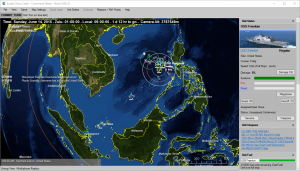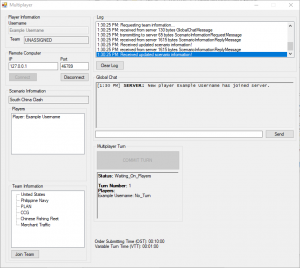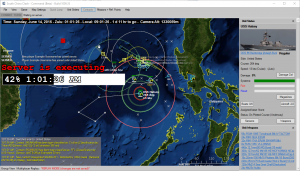Climbing ever higher: Command PE v1.15 released
 It has been almost a year since the release of PE v1.14.5, and a good 3.5 months since our most recent user conference at Farnborough. We are confident, however, that our pro customers will agree: Command PE v1.15 is here, and it has been worth the wait.
It has been almost a year since the release of PE v1.14.5, and a good 3.5 months since our most recent user conference at Farnborough. We are confident, however, that our pro customers will agree: Command PE v1.15 is here, and it has been worth the wait.
You can read the full release notes for the new update HERE.
Arguably eclipsing v1.14 as the most significant CPE release so far, v1.15 incorporates two brand-new features that have long dominated the wishlists of our customers:
 |
 |
 |
1) WEGO-style multiplayer. Users can now host, join and play multiplayer game sessions using the familiar CPE user interface. There are several important characteristics that define this functionality in its current implementation:
- Currently up to 16 players are supported per session. These can have any type of posture between them (friendly, neutral, hostile etc.) so both vs. and cooperative play is possible, in any number of combinations (8v8, 16 vs AI and anything in between). The server runs at the customer premises (not hosted by WS or MatrixGames), and the overall architecture is optimized for a LAN environment.
- Being a WEGO type, play flow is broken down into simultaneously-resolved turns (those familiar with Combat Mission or BSG:Deadlock will feel right at home). All players submit their orders and then the scenario state advances over the specified turn duration. During execution, the players (optionally) receive snapshots of the scenario progression in order to visualize what is happening.
- Both the time available to issue orders (described as Order Submission Time or OST) and the actual step duration (described as Variable Turn Time or VTT) can change dynamically from one turn to another. This allows incorporating into the same session both long-duration events with minimal player intervention (e.g. a long transits) and also rapid action events where player intervention is frequent (e.g. close combat). Changing the OST value allows for providing the players with ample time to consider their decisions (in an MBX-style game) or, conversely, placing them under very limited available time to increase pressure.
- Both umpire and observer roles are supported. The umpire has complete “God powers” (ie. access to all scenario-editor features), and has two chances per turn to use them: First, immediately after all players commit their orders but before the turn is executed (at that point he can also change any of the player orders to his whim), and then again right after the turn execution and before players resume control. He can also change the OST and VTT durations as desired, as well as force-commit all players (no laggards!). If no player takes the umpire mantle, the pre- and post-turn adjudication phases are skipped altogether. The observer role has the same omniscience powers as the umpire, but lacks its omnipotence – he can only watch.
The initial version of the MP functionality is already in use at the USMC wargaming center with feedback having been nothing short of enthusiastic, and suggestions for tweaks & improvements are already being absorbed by the development team for future iterations. (And to pre-empt the question that everyone in the commercial space is about to ask: Yes, MP is also coming to CMO, but later. The commercial market has different priorities and the system must be adjusted to them before general release.)
 2) Command-line version. The heavy-duty analysts are going to be giddy with this; think Monte-Carlo on steroids. the command-line version shares the same simulation engine as CMANO/CPE, and all the powerful-pro only features, but completely ditches the graphical user interface in favor of using a console for basic feedback (plus of course any generated outputs as configured). The benefits of a command-line version of CPE are mainly two-fold:
2) Command-line version. The heavy-duty analysts are going to be giddy with this; think Monte-Carlo on steroids. the command-line version shares the same simulation engine as CMANO/CPE, and all the powerful-pro only features, but completely ditches the graphical user interface in favor of using a console for basic feedback (plus of course any generated outputs as configured). The benefits of a command-line version of CPE are mainly two-fold:
- Being scriptable and thus automated. It can thus be incorporated into an automated analysis toolchain. It is trivial to launch either one or multiple instances for different analysis jobs, both in-sequence and in parallel.
- Lacking the GUI elements of the full-fledged CPE edition, this version is even faster and more efficient (as a point of comparison, the CLI executable is just over 5MB in disk size, compared to full-CPE’s 12MB). This makes it possible to run even more instances in the same machine.
Both the automation ability and the increased performance and instance density point to usage in massive-scale analysis, machine-learning inputs and other similar tasks.
These two features are not the only ones by far in the new update. Other additions include:
- All the features and improvements of CMANO v1.15 have been incorporated.
- Substantial performance improvements both on the GUI and core simulation engine.
- All the tweaks and additions since the release of PE v1.14.5 have been rolled-up.
- A new UI feature (fixed-side colors, useful for MBX-style games) has been added.
- The Monte-Carlo mode can now run in both coarse (1-sec pulse) and finegrained (0.1-sec pulse) time modes.
- A new mechanics override has been added: Public.NoContactExchange. When activated, friendly sides do not automatically exchange contact information (new or updated contacts) or any contact-related messages. (The default behavior is that they do). This can be useful in order to route contact information & exchange through other network-modelling systems.
- Simulation tweaks for submarines, including new behaviors for vessels with lithium-ion batteries (such as the new submarine Ōryū).
- When using DIS to connect to a federated simulation, it is now possible to “pin” a specific network adapter.
- The Lua TCP/IP socket now supports a range of different encoding modes (Big-endian, Unicode, ASCII, UTF-7/8/32 etc.), to better adjust to different connector types.
- The formation editor is now also usable for airgroups.
- Updated content (databases, scenarios, tutorials, Tacview objects etc.)
Command PE v1.15 is now available for download by professional users. The WS development team is already busy collating early feedback and integrating it in future iterations of the product.
For more information on Command PE, see the dedicated product page here.





